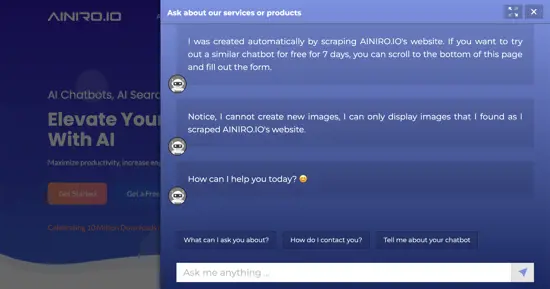The Smallest AI Chatbot in the World, and Why it Matters

In our previous article we discussed how technology should be your last question when choosing an AI chatbot. However, size of your AI chatbot is important, and for most non-technical people, it might come as a surprise to learn that the smaller your AI chatbot is, the better!
On the internet size is everything. According to research about page load speed a site that takes 10 seconds to load on a mobile phone, increases the bounce rate by 123% compared to a site that loads in 1 second. If you add a heavy AI chatbot to your page, page load time might easily double, significantly increasing bounce rate. Adding an AI chatbot to increase engagement might in fact reduce engagement.
53% of your mobile users will leave your page if it takes more than 3 seconds to load, and website conversion drops by 4.42% for each additional second you add to your page load speed
This implies that if you've got a page that loads in 2 seconds, and you add an AI chatbot to it that doubles its page load time, you will reduce conversions by 8.8% and 53% of your users will simply leave before the page loads.
The 1 second rule
If you've created an amazing website, you've probably added several widgets to it; a contact form, maybe a news letter signup, some animations - In addition to lots of CSS to make sure it looks awesome. It might not seem like a lot for you to add 2 more seconds to your page load - However, the page load time accumulates, and all of these widgets comes with a page load cost.
1 second multiplied by 10 widgets becomes 10 seconds in total
This implies that adding a 2 second AI chatbot to your page, drastically reduces conversions and increases your bounce rate. The by far most important technological metric when choosing an AI chatbot is in fact page load speed.
Optimising your chatbot
If you use developer tools to inspect this page, you will see that the average page load speed of our AI chatbot is 0.4 seconds on an empty cache. Admittedly, we're using Bootstrap CSS, reCAPTCHA, and a lot of other widgets that are "far from optimal", but the AI chatbot itself loads in 0.4 seconds. We can't answer for reCAPTCHA and Bootstrap, but we can answer for our AI chatbot, and it is blistering fast.
JavaScript and CSS, Less is More
First of all the JavaScript is tiny, in fact the entire JavaScript for our chatbot is 4.1KB, and its CSS is 2.5KB. These are the two only files the chatbot adds to your page. Only when you open the chatbot, it will load additional resources, such as reCAPTCHA, our socket library, the Markdown helper library, etc. Notice, depending upon what theme you choose, it might download an additional CSS file of some few hundred bytes, and two font libraries. However, the total amount of download our AI chatbot adds to your page is less then 100KB.
Since a typical web page downloads more than 1MB of resources, sometimes 3MB, this implies that our AI chatbot will never add more than maximum 10% of additional bandwidth to your web page. This is achieved by aggressive JavaScript and CSS optimisations, in addition to minifying our resources to remove comments and white spaces.
Considering an AI chatbot is typically the most important element on your website, adding less than 10% of additional bandwidth is a feat that have taken us a lot of time to implement.
CDN
CDN is an acronym that means Content Delivery Network. A good CDN will download your static resources to servers physically close to where the user is accessing your page, to such further optimise page load speeds. To understand the importance of this, realise that simply requesting a resource from Israel in Cyprus where I live requires 76 milliseconds of "network overhead", or TCP latency. Israel is 20 minutes of flight time from Cyprus. From the US to Ukraine or India the same number becomes 500 milliseconds!
A great CDN will copy all static resources, and serve these locally, sometimes reducing latency from several hundreds of milliseconds to 5 or 10 milliseconds. If you're in the US for instance, and you try to access a JavaScript file from Ukraine, the TCP latency for that by itself becomes 0.5 seconds. If you add a CDN it's reduced to 0.01 seconds. If your chatbot is downloading 10 files, you've now reduced overhead from 5 seconds to 0.1 second.
At AINIRO we are agressively using CDN technology to reduce page load times, which further speeds up things.
Wrapping up
When it comes to AI people are often "blinded by bling". Having an amazing good looking chatbot is important, but if only 1% of users gets to see it because they click the back button before the page loads, it's really quite irrelevant how "amazing" your AI chatbot is.
It's therefor crucial that you research the page load time of your AI chatbot before choosing an AI chatbot. If you have no idea how to do this, then get help from somebody that does. However, the process is quite simple; Click F12 in Google Chrome and look at your network tab. Try to separate what is the AI chatbot and what are other unrelated resources, and see how much time these will spend loading, and how many kilobytes of data they transfer in total.
If this number is more than 1MB, and it spends more than 3 seconds to load in total, you are probably better choosing another AI chatbot provider - Because today, there are no reasons why an AI chatbot should be spending more than at most some few hundres kilobytes of resources in total, and 1 second to load - And if it does, it will hurt your page in the end. Below you can find our metrics.
- 4.1KB of JavaScript
- 2.5KB of CSS
- 50KB of fonts
- Less than 100KB in total
- 0.4 seconds to load in total
When you choose an AI chatbot provider, regardless of who you choose, they should never be significantly higher than the above metrics - Because if they are, you will loose customers instead of gaining customers because of your AI chatbot project.
A piece of final advice; Spend your time when choosing an AI chatbot, and do not jump for the first one you find when using Google to search for one. It might just be the difference that truly sets your AI chatbot apart from the rest.




